
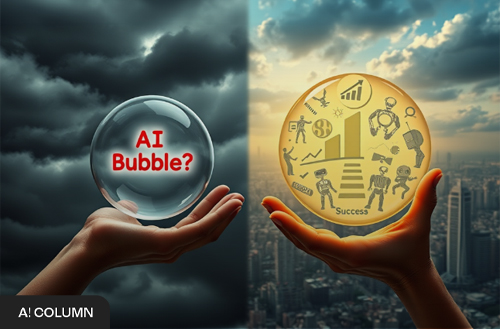
Does AI Make Money?
On AI and Tech #4

Columnist
Seong-joong Kang Digital Strategy Team


Key Take away
- There has been speculation about the AI bubble, suggesting AI doesn’t generate profits.
- Nevertheless, some companies are making money.
- Until the arrival of physical AI, we must keep pushing forward.
Hello, and welcome to the fourth installment of this column. Today's topic explores the looming clouds over AI and highlights companies still profiting despite these challenges. I'll also share thoughts on how long we should continue running this race.
1 The AI Bubble Theory
On July 25, 2024, discussions about an AI bubble began earnestly. The issue collided with the Yen Carry Trade, leading to a market downturn in the form of a "Black Monday" on August 5. Numerous debates ensued around this topic. Reports emerged indicating that even OpenAI requires $700,000 daily (approximately 969.5 million won) to operate and could face a cash crunch within 12 months due to projected losses of up to $5 billion (about 6.92 trillion won) this year. In other words, if OpenAI isn’t making money, how could we expect other companies to fare any better?
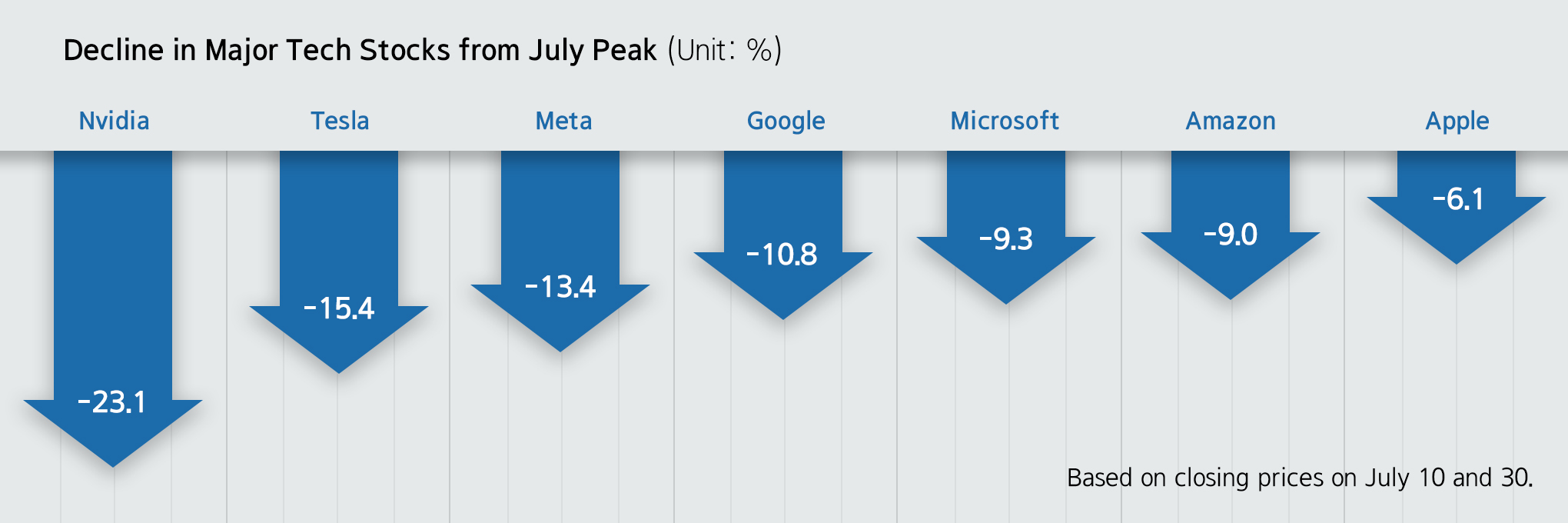
Source: Maeil Business Newpaper
Let’s briefly summarize the perspectives of the AI bubble theory and its counterpoint, the optimism for AI.
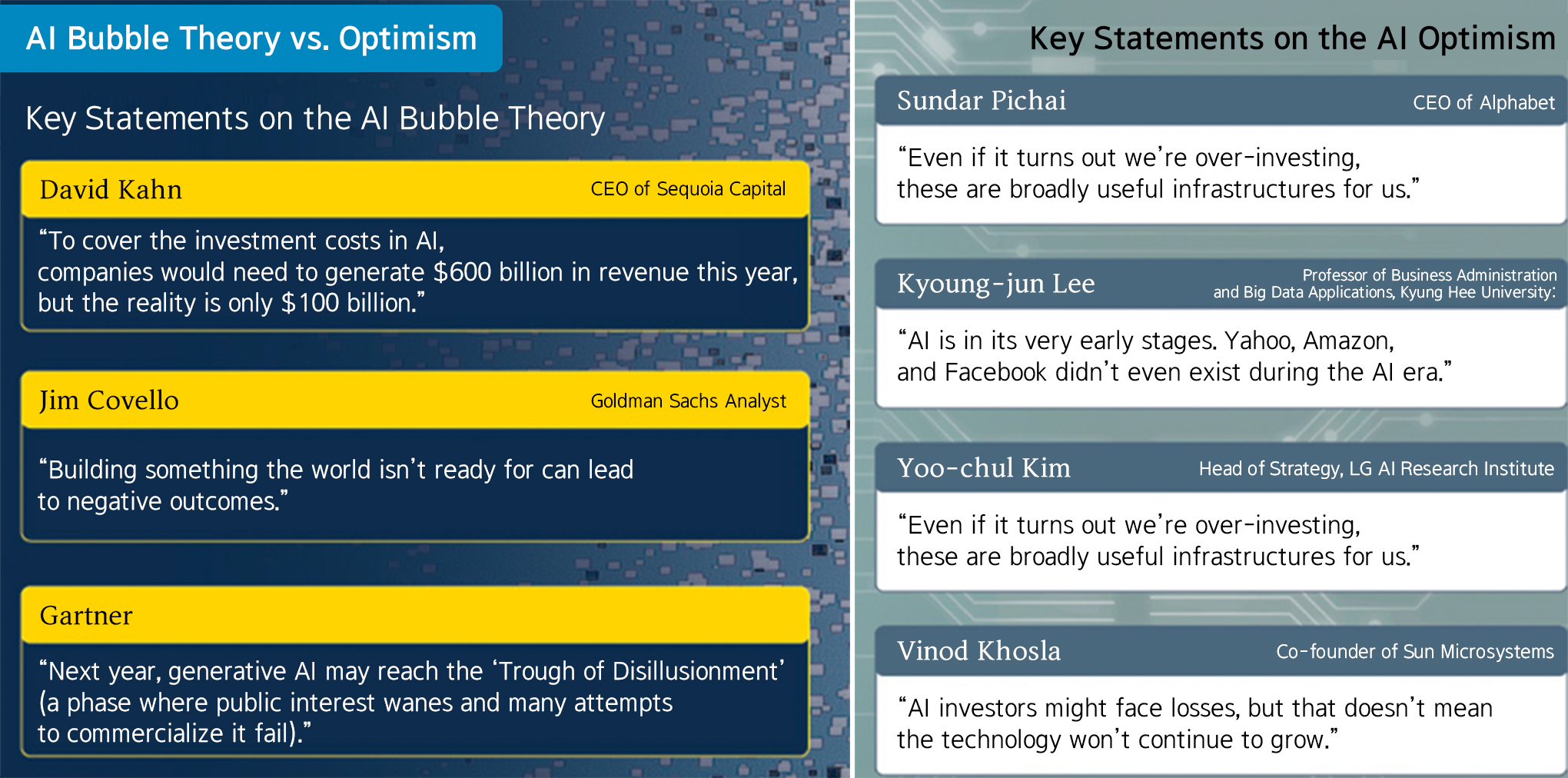
Source: “AI is the Second Dot-com Bubble”
vs. “It’s Just a Stock Bubble, Not an Industry Bubble”
- Bubble Theory (Skeptics): The question isn’t how much we’ve invested but when and how we will recoup those investments.
- Optimists: There’s always a way. Isn’t it too early to jump to conclusions?
It remains challenging to definitively state whether the skeptics or the optimists are right. However, one thing is certain: companies making money will always exist.
2 So, Who’s Making Money?
1) Walmart
On August 16, Walmart announced its latest earnings, revealing record-high stock prices due to its swift adoption of AI, which met market expectations.
According to the global corporate performance data from Korea Investment & Securities, Walmart's sales for the second quarter of fiscal year 2025 (May to July 2024) reached $169.3 billion, a 4.8% increase year-on-year. The company's non-GAAP earnings per share (EPS) totaled $0.67, up 9.8% year-on-year. While sales aligned with market expectations, EPS exceeded them by 3.1%.
During the earnings call, the CEO highlighted several points:
- The company has enhanced over 850 million marketing data points using generative AI, incorporating AI-powered search functions beyond simple searches to interactive tools that help customers choose the best products.
- Walmart utilizes data from other companies and large language models while developing its models.
- Generative AI has been employed to refine the product catalog, significantly impacting everything from helping customers find and purchase desired products to managing inventory within the network and fulfilling orders.
- Several large language models have been used to create or improve more than 850 million data points accurately.
While these points echo announcements made as early as 2023, the significance lies in the CEO’s statement:
"Without generative AI, completing these tasks within the same timeframe would have required nearly 100 times the current workforce."
In the U.S., effective communication and precise guidance are crucial, making the CEO’s public endorsement of AI's advantages particularly noteworthy.
2) Various Domestic Companies
Though some cases might seem small when viewed individually, together, they form a meaningful reference point.
For example, 1Z LABS (https://www.1zlabs.com/) developed Creative AI, an AI SaaS solution adopted by Market Kurly. Previously, it took a team of three people about 20 minutes to create content—just for the production phase. With Creative AI, a person can manage the entire process, from planning to production, in just 10 minutes.
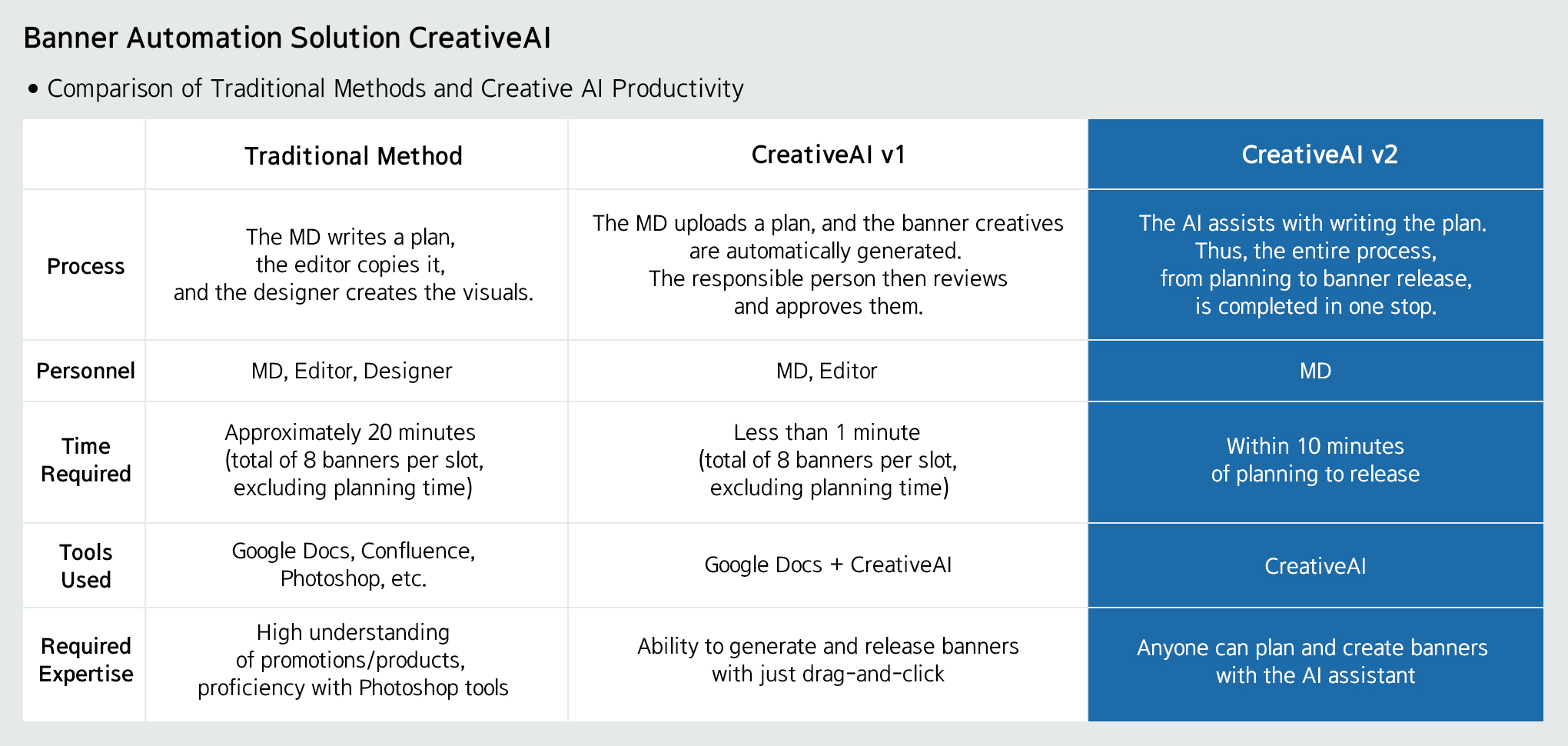
Source: 1Z LABS Profile
As illustrated in the image below, users click on the type of banner they need and proceed with the work, even generating images as required.
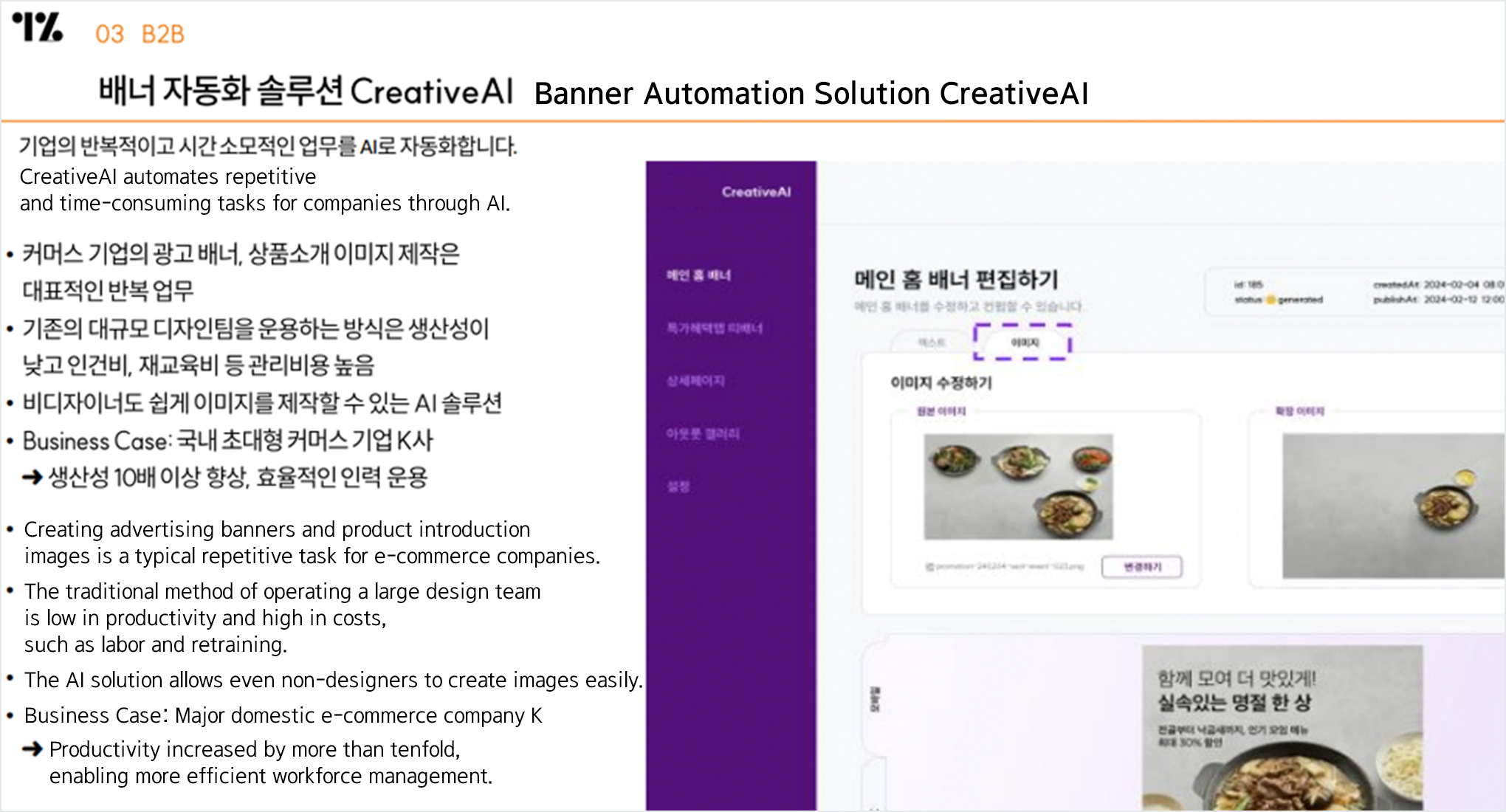
Source: 1Z LABS Profile
In truth, it's not about 'which tool was used.' What truly matters is ‘how’ AI’s capabilities are applied to specific domains and, more importantly, how they are leveraged to achieve tangible results.
I have consistently emphasized the importance of “tools,” advocating for exploring and applying any tool that offers even a marginal benefit. The market is replete with tools similar to the examples mentioned, which automate the creation of advertising banners, product images, and content. However, what distinguishes these companies is their proactive implementation of these tools, optimizing AI for their business processes and reaping the benefits.
The case of VCAT.AI is illustrative in this regard. An overview of its enterprise services reveals numerous use cases, demonstrating how different companies have adapted a single tool uniquely to meet their specific needs.

A case where production was automated using RPA and API integration

A case where multiple departments customized a single collaborative space for production

A case of consistent global content production by linking with in-house Digital Asset Management
3 The Wave of Change
Significant changes are emerging in the realm of tool utilization. The shift is moving away from merely providing software to customers toward an integrated approach that combines all the processes and functions needed to achieve the customer’s goals. To put it in more complex terms, this evolution can be described as follows:
1) Software-as-a-Service (SaaS) to Service-as-a-Software
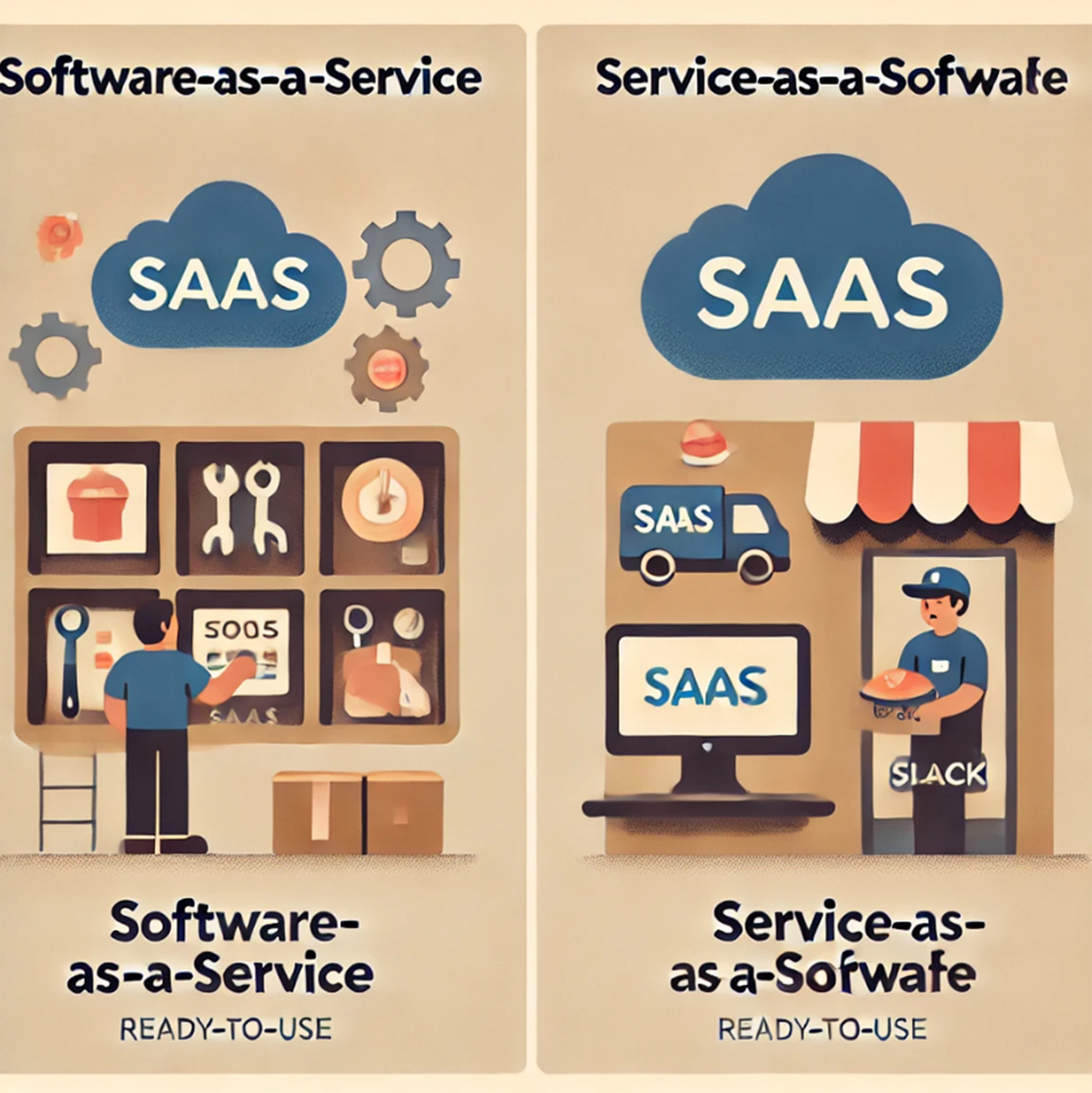
Software-as-a-Service(SaaS) ➔ Service-as-a-Software
Source: Self-generated using Dall-E
1) Software-as-a-Service (SaaS): "We have a great product. Go ahead and use it. How you use it is entirely up to you." (To use a culinary analogy: "We provide a shared kitchen. Cook whatever you want with our fancy kitchen tools and run your business.")
2) Service-as-a-Software: "By using the services we provide, you can achieve whatever you desire. Customized software is available to help you reach your service goals." (In the culinary context: "We provide not only kitchen facilities and tools but also kitchen management services, cooking methods, and even ingredient supply. We offer software that manages all these aspects for you.")
One provides tools, while the other offers services and results.
From the perspective of those skeptical about AI, one might dismissively ask, "Is that all?" However, when considering the approach of “integrating all processes and functionalities to achieve the customer's desired outcomes,” there are several key points I want to emphasize:
1. There was thoughtful consideration and planning on which AI tools to use in which areas.
2. Even if the AI implementation wasn’t perfect, there was an attempt to apply it.
3. This experience, no matter how minor, will remain with the company and its employees, adding to their collective expertise.
As I have stressed in previous columns, “the path of AI will not be easy, and not everyone will succeed.” Yet, despite the skepticism, a few companies and individuals quietly continue to make strides and achieve results.
4 AI: How Long Should We Keep Going?
1) Looking at AI-Related Patent Rankings by Country
Expanding the world of AI to a national level, we see the following landscape:
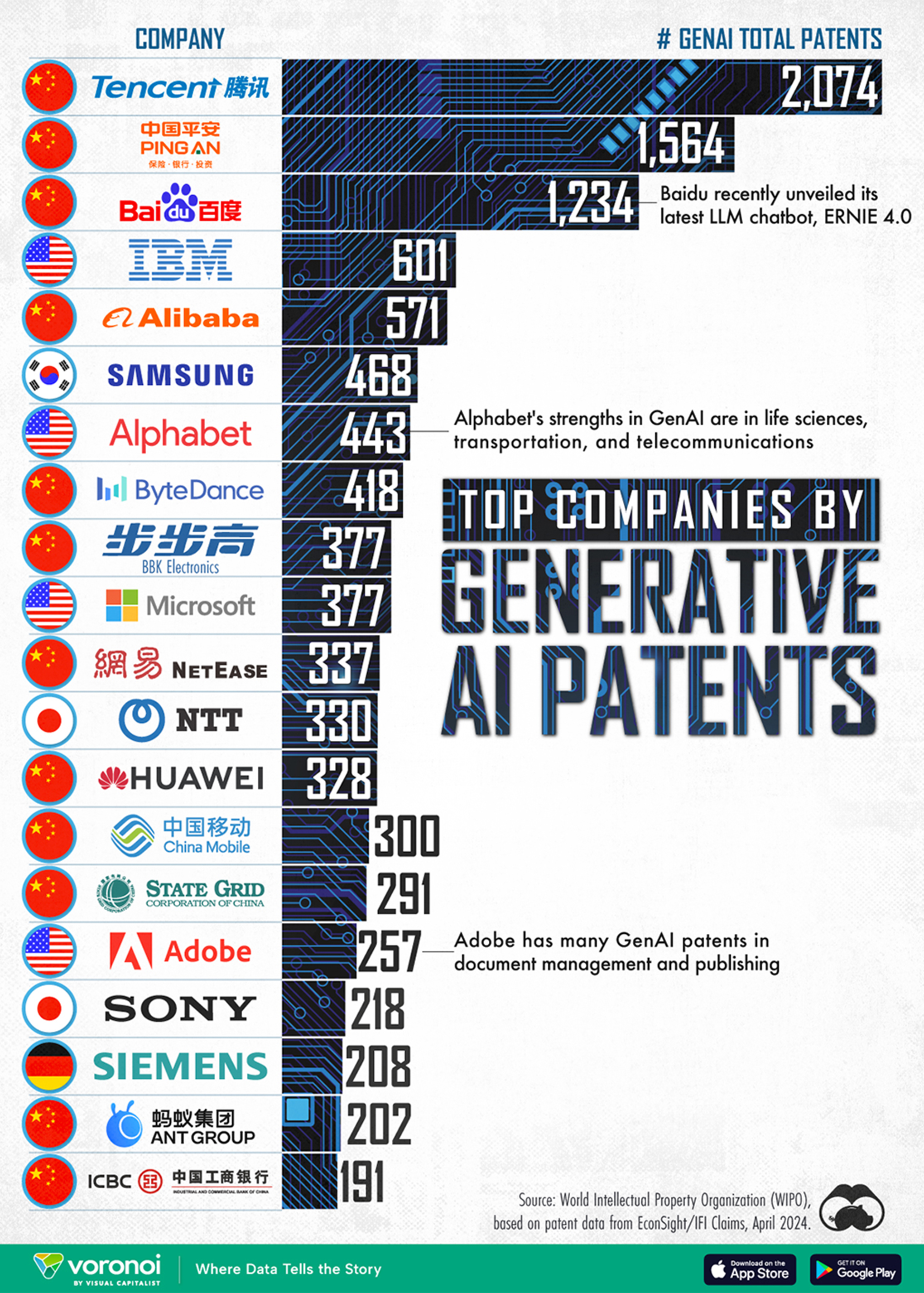
Source: Ranked: Top Companies by Generative AI Patents (visualcapitalist.com)
Most leading companies are Chinese, but Samsung also demonstrates impressive strength, showing where our country stands. We must watch closely as these numerous patents are mass-produced and become part of our everyday reality.
2) Examining Trends from the VC Industry
Page 13 of Coatue's EMW 2024 report illustrates that this trend will likely persist, at least until the advent of "physical AI."
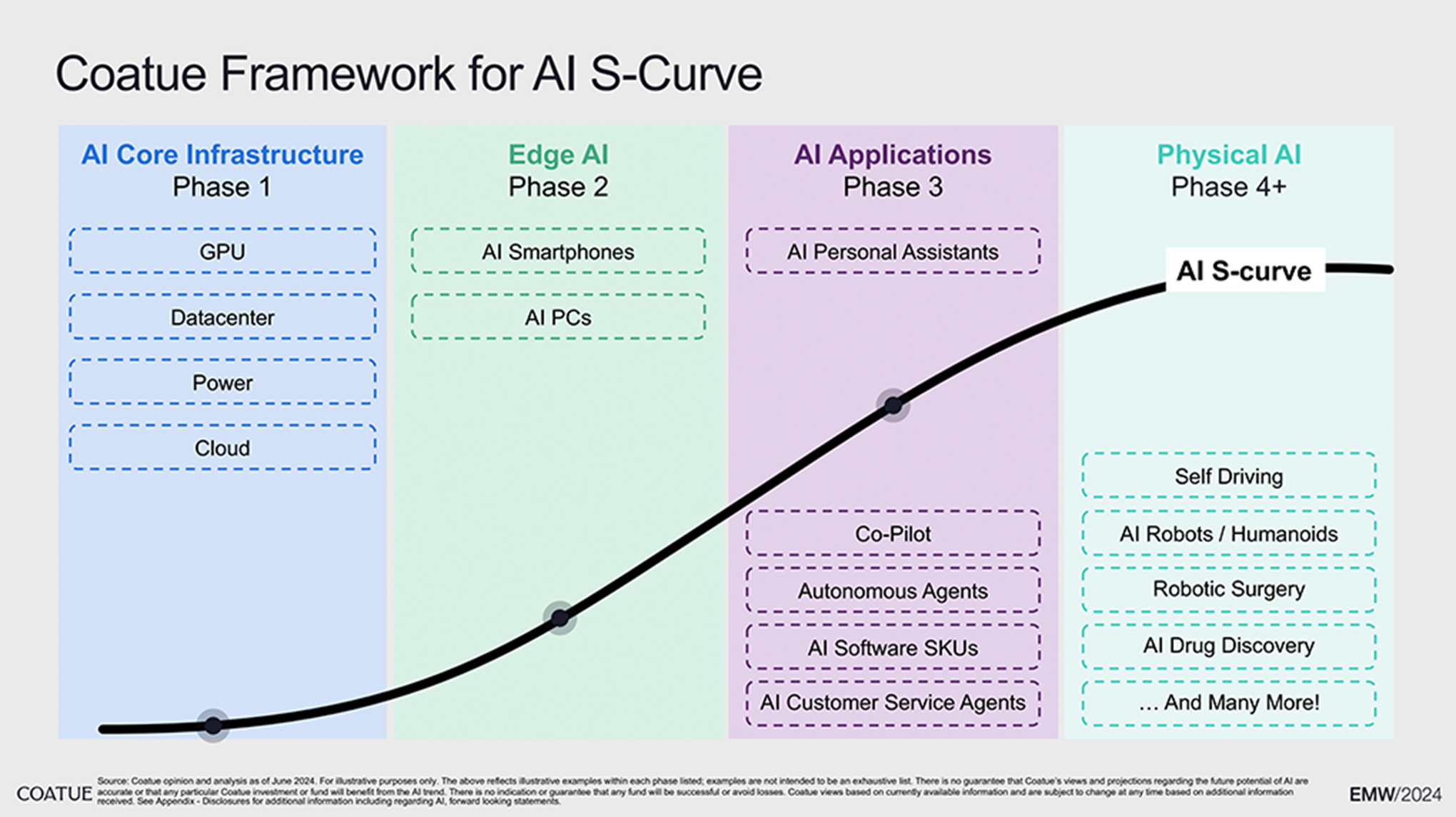
Source: Coatue EMW 2024 - Keynote.pdf - Google Drive,
Coatue's 2024 Tech Stock Investment Recipe (maily.so)
3) Considering the Perspective of Leading Companies like OpenAI
An article from July 12, 2024, notes that OpenAI describes five stages on the path to AGI: (1) Chatbots, (2) Reasoners, (3) Agents, (4) Innovators, and (5) Organizations. They state that they are currently approaching stage two.
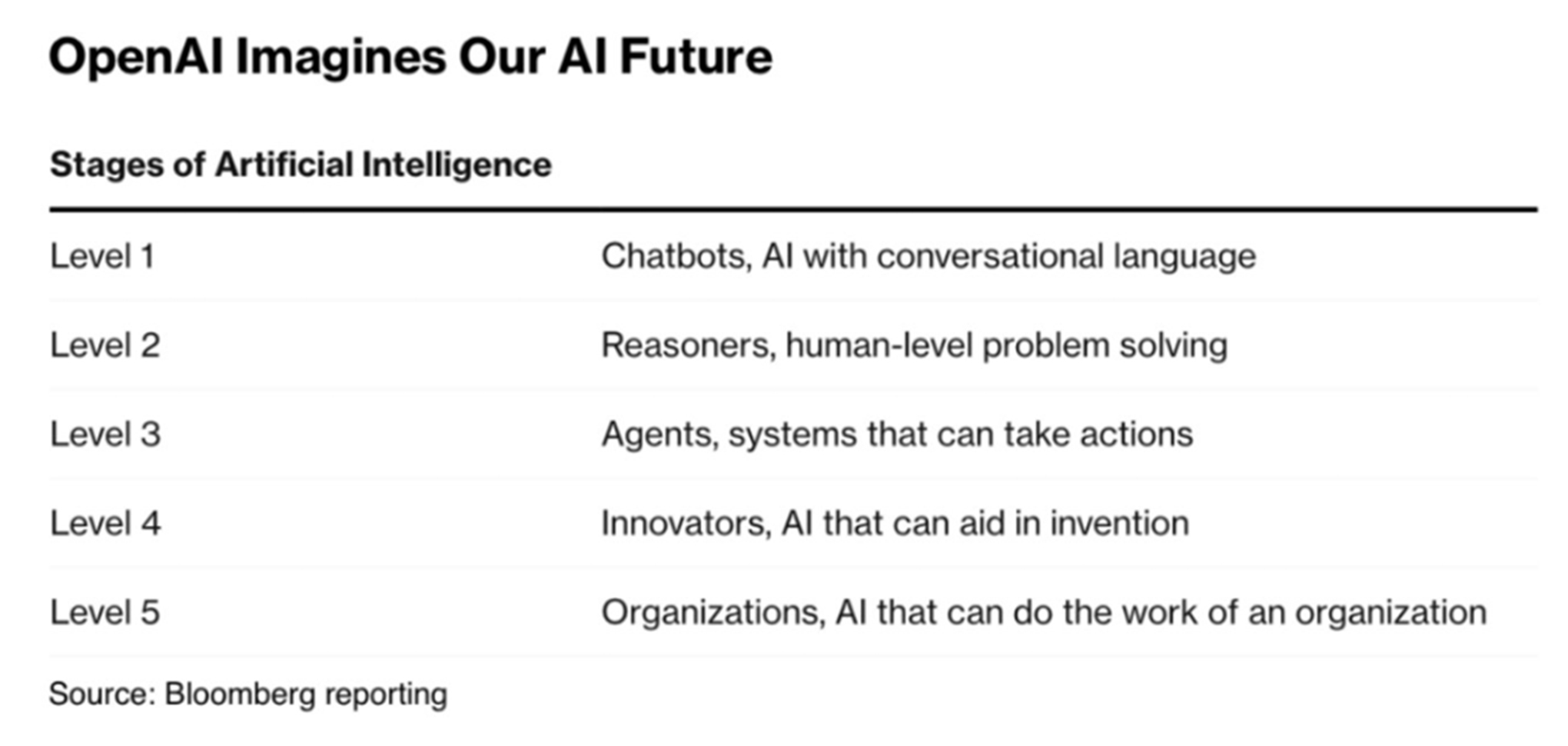
Source: OpenAI Sets Levels to
Track Progress Toward Superintelligent AI - Bloomberg
#OUTRO
Time flies. ChatGPT was launched on December 1, 2022. This summer was intense, but autumn began on August 7. Once this fall passes, it will be nearly two years since ChatGPT’s release. The current resurgence of COVID-19 first appeared on December 31, 2019—almost five years ago. Indeed, time moves quickly.
So much has changed in such a short time. Tools like Midjourney, ChatGPT, Flux 1, Figma, and HeyGen have all rapidly evolved, frequently updating their features. To understand how quickly, let’s look at a real-world example. By now, everyone is familiar with HeyGen. Consider what HeyGen has accomplished:
- Achieved annual revenue of $1 million within seven months of product launch
- Reached annual revenue of $20 million within two years of product launch
- Held conversations with 1,400 customers over 200 days, averaging seven meetings daily
- Released new features weekly for seven months
- Secured $60 million (about 80 billion won) in Series A funding
- Acquired over 40,000 paying business customers worldwide, ranging from manufacturers to small businesses, global nonprofits, and Fortune 500 companies
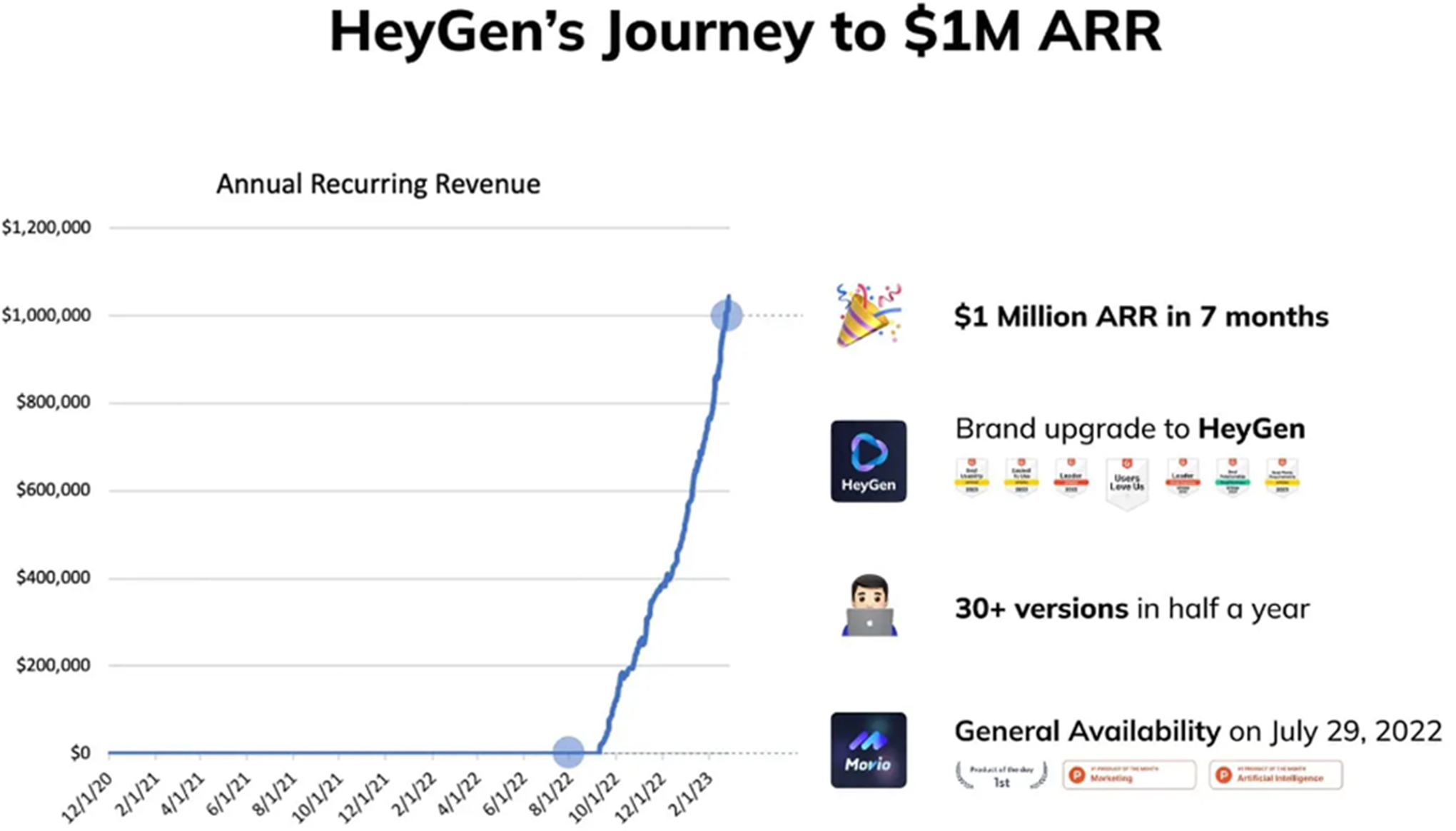
Source: HeyGen Founder’s Blog, Founder Story Newsletter
This gives me pause for reflection. How many features have I improved, how much have I changed, and how much work have I accomplished in such a short time? It reminds me of something a respected executive at our company once said: “I decided to create a version of myself that I am happy with.” When faced with choices, I strive to make the best decision that leads to a better version of myself. I believe this is the key to growth. Taking small steps each day will make me better than I was yesterday. To everyone working with AI, let’s keep pushing forward.
References
- Growing Concerns Over 'AI Bubble'... Big Tech Can't Stop Aggressive Investments https://m.news.nate.com/view/20240805n04144
- $11 Billion Investment Yet Running Out of Cash in a Year? What's Happening with OpenAI https://news.mt.co.kr/mtview.php?no=2024072616501890308
- [Is AI a Money Pit? ①] Can AI Make Money? https://kidd.co.kr/news/237719
- 'AI Skepticism' Quelled by American Retail Giant https://www.hankyung.com/article/2024081677431
- Record-Breaking Performance by Walmart... Surprising Employees with Heavy Lifting https://www.hankyung.com/article/2024081677281
- How Walmart Business Is Revolutionizing B2B Shopping With AI: A Deep Dive Into The Future Of Retail (forbes.com)
- [WeeklyEDGE] A New SaaS Is Coming: Service-as-a-Software (stibee.com)
- AI Leads A Service-As-Software Paradigm Shift (forbes.com)
- What the AI Bubble Debate Is Missing (maily.so)
-
Like
1 -
Recommend
1 -
Thumbs up
1 -
Supporting
1 -
Want follow-up article
1





